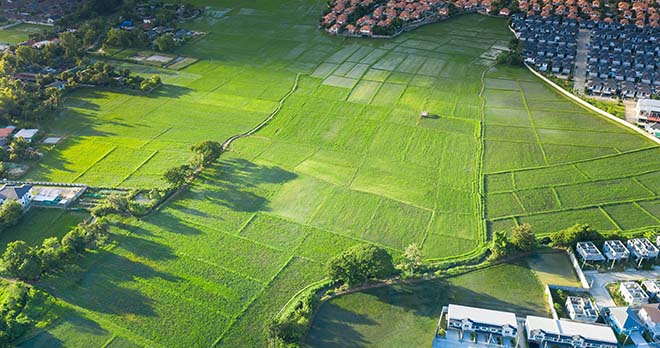The Environment Act 2021 and other recent developments – a quick guide for the real estate sector

There have been some fairly major developments in environmental law in recent years, most particularly the Environment Act 2021 finally came through parliament from bill stage on the 9th November 2021.
Not all of the provisions are yet in force however there are a number of key points which are important for landowners and developers to know. There has also been a development in nutrient neutrality due to a recent EU case.
Here we will cover three specific areas covered in the new laws that could be of interest to those in the real estate sector:
Biodiversity Net Gain
What is Biodiversity Net Gain?
At the time of writing, as of November 2022 Biodiversity Net Gain will be set at a mandatory minimum 10% for all developments in England under the Town and Country Planning Act.
Though it is not currently in force (due to come into force in November 2023) it is being trialled by a number of Local Councils (some councils are using a larger figure than 10%).
Who will the Biodiversity Net Gain law affect?
This will affect all developments (with very limited exemptions). However, given the methods of achieving this this will be of interest to many who have large estates as the Biodiversity Net Gain can be achieved by offsite provision as well as onsite
What is required to meet the Biodiversity Net Gain level?
Biodiversity value must increase by at least 10%. It should be noted that the increase in biodiversity of given land is from the 30 January 2020 not the date of the development. This is to ensure that landowners do not artificially lower biodiversity value prior to a development to achieve a higher gain later.
How is Biodiversity Net Gain calculated and how is it achieved?
There are three methods for calculating Biodiversity Net Gain, and they can be used individually or together:
- Onsite provision – Altering biodiversity on the development itself
- Offsite provision – Altering biodiversity on another site
- Statutory credits – Purchasing ‘credits’ from the government (details of this have not yet been announced).
The most straight forward is option 1 but this will often be unattractive for developers as it requires long term maintenance of a site (habitat must be maintained for a minimum of 30 years)
The second method has additional factors with what is known as the DEFRA Biodiversity Metric. This takes into account the distance of offsite provision from the actual site and penalises the created habitat accordingly, if it is in the same local authority there is no penalty but a 25% discount for a neighbouring authority and 50% if further away.
Furthermore, not all biodiversity is treated equally. Local Nature Recovery Strategies mean that there will be weighted values attributed to certain sites that fall within this designation. Therefore, to calculate credits, there will need to be an element of planning required.
Any other considerations?
It will be a condition of planning permission that a biodiversity gain plan has been submitted to the local authority and been approved.
The opportunities of Biodiversity Net Gain law
There is likely to be significant demand for offsite provision with habitat credit being sold to developers to meet the requirements of the act. This will be of particular interest to landowners who will have the option of maintaining habitat themselves or leasing land to a third party who will maintain the land.
It is early days but we are already seeing initial agreement for arrangements such as this given the starting point for looking at land is January 2020, so increasing biodiversity of sites ahead if the Act coming into force can begin now.
Nutrient Neutrality
What is Nutrient Neutrality?
Nutrient Neutrality is when a particular use of land does not result in an increase in particular chemical levels in watercourse beyond current levels.
This is important as the chemicals in question being Nitrates and Phosphates in elevated levels can cause an increase in the growth of Algae which in turn reduces oxygen levels in the water which in turn reduces biodiversity in a watercourse.
This is now a major issue due to a European Union case known as the ‘Dutch Nitrogen case’: this has meant that measure to mitigate the impact on water bodies can no longer be postponed and that mitigation measure must be certain at the time of the assessment.
Who is affected by Nutrient Neutrality law?
Where there is a change of land use (i.e. a development) in certain local authorities (this number is increasing) that may affect nutrients in watercourses. Therefore, this is a consideration for landowners and developers.
What is required of developers for Nutrient Neutrality and how is it achieved?
A habitat regulations assessment is now required prior to planning permission in affected areas.
It will need to be demonstrated that there are nutrient neutrality methods in place and if required there are mitigation methods. Each local authority has catchment specific calculators to calculate the nutrient burden.
There are both options to achieve nutrient neutrality onsite as well as offsite by acquiring nutrient credits
This means that any developments which results in an increase in dwelling may be subject to a requirement for an assessment at the planning stage dependant on the area the development is located
Are there any opportunities arising out of Nutrient Neutrality law?
Offsite options provide alternative solutions, for example certain types of agricultural land use have a high nutrient leeching rate but altering its use to land which has a lower leeching rate (i.e. woodland) can then be use to offset development. This creates opportunities for landowners and in particular farmers to diversify.
It should be noted it is likely that offsite provision will be required to be in the same local authority as the development site.
How is this connected to the Environment Act 2021?
This act introduces conservation covenants (which will be explained below) but in short these are private agreements to allow enforcement of management of mitigation land.
Conservation covenants
What is a conservation covenant?
These came into force on the 30 September 2022 and are:
‘A private voluntary agreement between a landowner and a ‘responsible body’ (such as a conservation organisation or public body) to do or not to do something on their land for a conservation purpose of public good’
Who will be affected by conservation covenants?
A conservation covenant will be made between landowners and third parties (note this is a ‘responsible body’ designated by the Secretary of State) to enforce obligations on land. It is likely these third parties will be local authorities to begin with and then probably extended to environmental protection charities and bodies.
How will these conservation covenants work?
Conservation covenants are an instrument that will be used to support the new Biodiversity Net Gain requirements (see part 1 of this article) but they will also have wider usage (see part 2 Nutrient Neutrality). There are further possibilities such as:
- payment for ecosystem services – i.e. flood prevention;
- use as an asset of community value, for example an area which has public benefit which the owner wishes to protect long term to the use is continued;
- use as an alternative to purchasing land to secure long-term usage i.e. wildlife protection or ability to insert on the sale of land to protect the land long term.
They will be secured by way of a land charge and shown on a Local Authority Search.
Are there any opportunities that may arise from the use of conservation covenants?
As stated these covenants are likely to be applicable to parts 1 and 2 of this article in the enforcement of management responsibilities of land, as an alternative to s106 agreements.
It should be noted that it is the land that is bound by the agreement, so when/if it passes from owner to owner it binds future landowners even if the obligation is positive (as opposed to normal positive covenants). Both freeholders and leaseholders (if their lease is over 7 years), can enter into these covenants.
Guidance on conservation covenants has recently been issued by DEFRA, which can be accessed here.
If you are a landowner or developer, and are looking for legal advice relating to the Environment Act, please find out more and contact us about our range of legal services for those in the real estate sector here.
Rob Walton is a Partner in the Real Estate team with specialist knowledge in the renewable energy sector and environment and holds a Masters in Conservation Biology.
Call Rob







